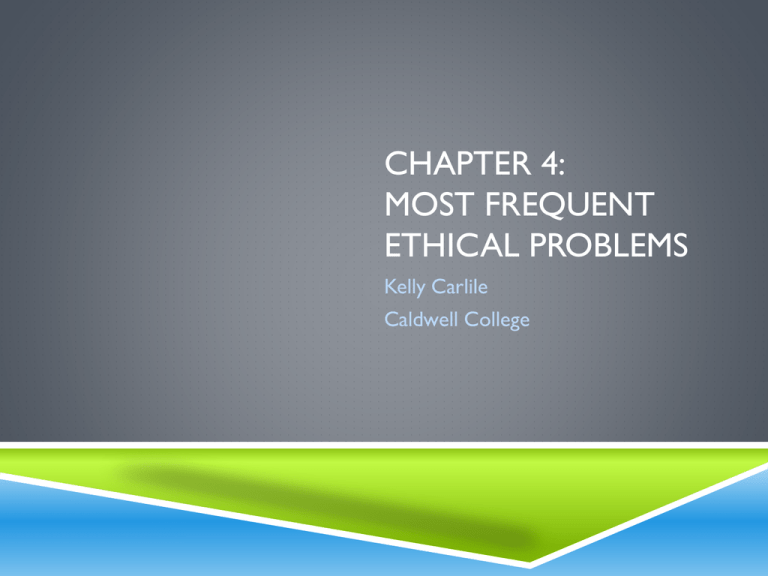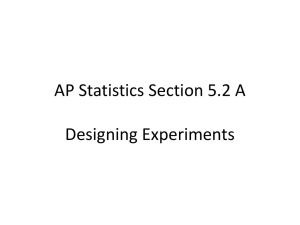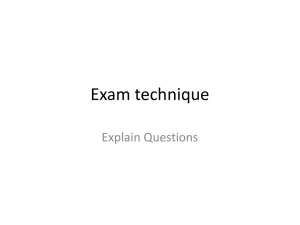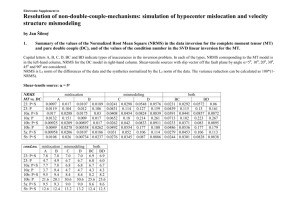Chap 4 Frequent Ethical Problems
advertisement

CHAPTER 4: MOST FREQUENT ETHICAL PROBLEMS Kelly Carlile Caldwell College OVERVIEW Introduction Top 5 Ethical Concerns Top 10 Standards Related to 6-10 Standards Related to Other Fields Ethical Concerns for Other Fields Another Big Concern Related Codes of Ethics Questions INTRODUCTION No official, systematic surveys of behavioral practitioners to determine the most frequently occurring Based on scenarios written by workshop attendees TOP 5 ETHICAL CONCERNS Ethical Concerns Ethical Standard 1 Right to Effective Treatment 2.10B 2 Responsibility to Recommend Scientifically Supported and Most Effective Treatments 2.10A Behavior Analysts Assessments are Sufficient to Provide Appropriate Substantiation for their Findings 3.0A 4 Dual Relationships and Conflicts 1.06A,B 5 Functional Assessment 3.02 3 RIGHT TO EFFECTIVE TREATMENT (2.10B) 2.10 Treatment Efficacy (b) Clients have a right to effective treatment (i.e., based on the research literature and adapted to the individual client) RIGHT TO EFFECTIVE TREATMENT (2.10B) Funding Unwillingness for school districts to pay Difficult to get insurance companies to reimburse Some still consider it experimental Not medically necessary More public school programs being started Lack of understanding of need Some states have age cut off and caps lifetime expenditures RIGHT TO EFFECTIVE TREATMENT (2.10B) $35 billion (Ganz, 2008) Direct Medical Costs Direct Non-Medical Costs Indirect Costs RIGHT TO EFFECTIVE TREATMENT (2.10B) Data Taking and Data Faking Don’t have time Know without the data Nonbehavioral professionals are in leadership roles Fake data and present as valid What are other reasons people may “fake” data? RIGHT TO EFFECTIVE TREATMENT (2.10B) Alternative Nonevidence –Based Treatments are Preferred Parents see as a “choice” More available than ABA services “Quick fix” What document exists now to assist with promotion of ABA? RIGHT TO EFFECTIVE TREATMENT (2.10B) Competing Lines of Authority Working as a team, but under guidance of psychiatrist Medication often chosen as treatment School district representative overshadows parent and teacher RESPONSIBILITY TO RECOMMEND SCIENTIFICALLY SUPPORTED AND MOST EFFECTIVE TREATMENTS (2.10A) 2.10 Treatment Efficacy (a) The behavior analyst always has the responsibility to recommend scientifically supported most effective treatments RESPONSIBILITY TO RECOMMEND SCIENTIFICALLY SUPPORTED AND MOST EFFECTIVE TREATMENTS (2.10A) Choice Like having options, rather than being told Want to do what is best What’s the harm in trying? Want hope Bored Why don’t we give parents a choice? RESPONSIBILITY TO RECOMMEND SCIENTIFICALLY SUPPORTED AND MOST EFFECTIVE TREATMENTS (2.10A) Competing Professions and Their Theories Importance of exercise Sensory diets Relaxation techniques What do you do when you are asked to implement a sensory diet? BEHAVIOR ANALYSTS ASSESSMENTS ARE SUFFICIENT TO PROVIDE APPROPRIATE SUBSTANTIATION FOR THEIR FINDINGS (3.0A) 3.0 Assessing Behavior (a) Behavior analysts’ assessments, recommendations, reports, and evaluative statements are based on information and techniques sufficient to provide appropriate substantiation for their findings BEHAVIOR ANALYSTS ASSESSMENTS ARE SUFFICIENT TO PROVIDE APPROPRIATE SUBSTANTIATION FOR THEIR FINDINGS (3.0A) Start intervention without assessment Recommend without seeing child Decisions not based on data What do you do when you are asked recommendations for a child you have never seen? DUAL RELATIONSHIPS AND CONFLICTS OF INTEREST (1.06A,B) 1.06 Dual Relationships and Conflicts of Interest (a) In many communities and situations, it may not be feasible or reasonable for behavior analysts to avoid social or other nonprofessional contacts with persons such as clients, students, supervisees, or research participants. Behavior analysts must always be sensitive to the potential harmful effects of other contacts on their work and on those persons with whom they deal. (b) A behavior analyst refrains from entering into or promising a personal, scientific, professional, financial, or other relationship with any such person if it appears likely that such a relationship reasonably might impair the behavior analyst’s objectivity or otherwise interfere with the behavior analyst’s ability to effectively perform his or her functions as a behavior analyst, or might harm or exploit the other party. DUAL RELATIONSHIPS AND CONFLICTS OF INTEREST (1.06A,B) Dual Relationships and Conflicts of Interest Any interaction with client beyond role of therapist Accepting gifts or food Many deny this effects judgment Also felt like they should cut family a break financially What is too much? Is it less ethical to accept a gift or to deny a gift? What should be done as a field to address this? FUNCTIONAL ASSESSMENT (3.02) 3.02 Functional Assessment (a) The behavior analyst conducts a functional assessment, as defined below, to provide the necessary data to develop an effective behavior change program. (b) Functional assessment includes a variety of systematic information-gathering activities regarding factors influencing the occurrence of a behavior (e.g., antecedents, consequences, setting events, or motivating operations) including interview, direct observation, and experimental analysis. FUNCTIONAL ASSESSMENT (3.02) Lack of resources Professional judgment Descriptive assessments TOP 10 ETHICAL CONCERNS Ethical Standard 1 Treatment Efficacy 2.10B 2 Responsibility to Recommend Scientifically Supported and Most Effective Treatments 2.10A 3 Assessing Behavior 3.0A 4 Dual Relationships and Conflicts 1.06A,B 5 Functional Assessment 3.02 6 Least Restrictive Procedures 4.10 7 Responsible for Appraisal of Alternative Treatments 2.10c 8 Responsibility to All Parties Affected by Behavioral Services 2.03 9 Reinforcement/Punishment 4.05 10 Environmental Conditions that Hamper Implementation 4.03 STANDARDS RELATED TO 6-10 # Standard Description Least Restrictive Procedures The behavior analyst reviews and appraises the restrictiveness of alternative interventions and always recommends the least restrictive procedures likely to be effective in dealing with a behavior problem 2.10c Treatment Efficacy Behavior analysts are responsible for review and appraisal of likely effects of all alternative treatments, including those provided by other disciplines and no intervention 2.03 Responsibility The behavior analyst’s responsibility is to all parties affected by behavioral services. 4.05 Reinforcement/Punishment The behavior analyst recommends reinforcement rather than punishment whenever possible. If punishment procedures are necessary, the behavior analyst always includes reinforcement procedures for alternative behavior in the program. 4.03 Environmental Conditions that Hamper Implementation If environmental conditions hamper implementation of the behavior analytic program, the behavior analyst seeks to eliminate the environmental constraints, or identifies in writing the obstacles to doing so. 4.10 PT CODE OF ETHICS BACB Guidelines Treatment Efficacy (2.10A,B) Assessing Behavior (3.0A) Dual Relationships and Conflicts of Interest (1.06A,B) Functional Assessment (3.02) Least Restrictive Procedures (4.10) Responsible for Appraisal of Alternative Treatments (2.10C) Responsibility to All Parties Affected by Behavioral Services (2.03) Reinforcement/Punishment (4.05) Environmental Conditions that Hamper Implementation (4.03) OT CODE OF ETHICS OT CODE OF ETHICS OT CODE OF ETHICS OT CODE OF ETHICS OT CODE OF ETHICS Ethical Standard 1 Treatment Efficacy 2.10B 2 Responsibility to Recommend Scientifically Supported and Most Effective Treatments 2.10A 3 Assessing Behavior 3.0A 4 Dual Relationships and Conflicts 1.06A,B 5 Functional Assessment 3.02 6 Least Restrictive Procedures 4.10 7 Responsible for Appraisal of Alternative Treatments 2.10c 8 Responsibility to All Parties Affected by Behavioral Services 2.03 9 Reinforcement/Punishment 4.05 10 Environmental Conditions that Hamper Implementation 4.03 ASHA CODE OF ETHICS ASHA CODE OF ETHICS ASHA CODE OF ETHICS Ethical Standard 1 Treatment Efficacy 2.10B 2 Responsibility to Recommend Scientifically Supported and Most Effective Treatments 2.10A 3 Assessing Behavior 3.0A 4 Dual Relationships and Conflicts 1.06A,B 5 Functional Assessment 3.02 6 Least Restrictive Procedures 4.10 7 Responsible for Appraisal of Alternative Treatments 2.10c 8 Responsibility to All Parties Affected by Behavioral Services 2.03 9 Reinforcement/Punishment 4.05 10 Environmental Conditions that Hamper Implementation 4.03 ART THERAPY CODE OF ETHICS ART THERAPY CODE OF ETHICS Ethical Standard 1 Treatment Efficacy 2.10B 2 Responsibility to Recommend Scientifically Supported and Most Effective Treatments 2.10A 3 Assessing Behavior 3.0A 4 Dual Relationships and Conflicts 1.06A,B 5 Functional Assessment 3.02 6 Least Restrictive Procedures 4.10 7 Responsible for Appraisal of Alternative Treatments 2.10c 8 Responsibility to All Parties Affected by Behavioral Services 2.03 9 Reinforcement/Punishment 4.05 10 Environmental Conditions that Hamper Implementation 4.03 NEA CODE OF ETHICS Least detailed Do not address any of the standards of the BACB guidelines Only address commitment to student and commitment to self NEA CODE OF ETHICS Ethical Standard 1 Treatment Efficacy 2.10B 2 Responsibility to Recommend Scientifically Supported and Most Effective Treatments 2.10A 3 Assessing Behavior 3.0A 4 Dual Relationships and Conflicts 1.06A,B 5 Functional Assessment 3.02 6 Least Restrictive Procedures 4.10 7 Responsible for Appraisal of Alternative Treatments 2.10c 8 Responsibility to All Parties Affected by Behavioral Services 2.03 9 Reinforcement/Punishment 4.05 10 Environmental Conditions that Hamper Implementation 4.03 APA CODE OF ETHICS 2.04 Bases for Scientific and Professional Judgments 3.05 Multiple Relationships 3.06 Conflict of Interest 3.10 Informed Consent 9.01 Bases for Assessments 9.02 Use of Assessments APA CODE OF ETHICS Ethical Standard 1 Treatment Efficacy 2.10B 2 Responsibility to Recommend Scientifically Supported and Most Effective Treatments 2.10A 3 Assessing Behavior 3.0A 4 Dual Relationships and Conflicts 1.06A,B 5 Functional Assessment 3.02 6 Least Restrictive Procedures 4.10 7 Responsible for Appraisal of Alternative Treatments 2.10c 8 Responsibility to All Parties Affected by Behavioral Services 2.03 9 Reinforcement/Punishment 4.05 10 Environmental Conditions that Hamper Implementation 4.03 ETHICAL ISSUES FOR OT/PT Recommendations not honored due to budget Space to treat Group students ETHICAL ISSUES FOR SPEECH Told limited number of students they can classify Told students will not be eligible, so do not assess Back to back sessions reduce IEP times Forced to group students ETHICAL ISSUES FOR TEACHERS Advocate for district first and student second Asked to address issues outside expertise Given behavior plans to implement with no training ETHICAL ISSUES FOR CST Told not to classify students with specific diagnosis, even though meet criteria for it Parent requests not always considered in “team” decision Public vs. Private Programs General education teachers not in agreement and sabotage placement if not in agreement or argue with parents unnecessarily Hold back special education students Advance grade levels without exposure to curriculum PROFESSIONAL ETHICS THAT RELATE TO TOP 10 CONCERNS Ethical Standard 1 Treatment Efficacy 2.10B 2 Responsibility to Recommend Scientifically Supported and Most Effective Treatments 2.10A 3 Assessing Behavior 3.0A 4 Dual Relationships and Conflicts 1.06A,B 5 Functional Assessment 3.02 6 Least Restrictive Procedures 4.10 7 Responsible for Appraisal of Alternative Treatments 2.10c 8 Responsibility to All Parties Affected by Behavioral Services 2.03 9 Reinforcement/Punishment 4.05 10 Environmental Conditions that Hamper Implementation 4.03 CAN YOU THINK OF AN EVEN BIGGER ETHICAL ISSUE NOT MENTIONED?? ETHICS AND TECHNOLOGY YouTube search revealed many Social Media Ethic guidelines need to be updated to reflect new technological advances. HOW TO HANDLE ETHICAL PROBLEMS To be continued . . . Chapter 17 QUESTIONS? RELATED CODES OF ETHICS Art Therapy Code of Ethics APA Code of Ethics OT Code of Ethics PT Code of Ethics NEA Code of Ethics THANK YOU!









